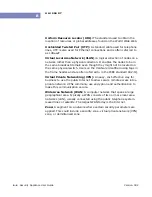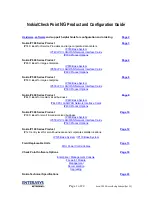
. . . . .
G L O S S A R Y
Version 3R2
Security Appliance User Guide
B-7
determines which key the freeGuard Blaze 2100 uses to encrypt or
decrypt packets.
Simple Network Management Protocol (SNMP):
forms part of the
internet protocol suite as defined by the Internet Engineering Task Force.
The protocol is used by network management systems for monitoring
network-attached devices for conditions that warrant administrative
attention.
Static Route:
A user-definable route that defines how a packet is to
move between a source and destination. Static routes are a manual
entry that allows administrators to set default-route mapping before the
beginning of a route. These routes work well in networks that have a
predictable path for all network traffic.
Subinterface:
A logical segment for a physical connection. A
subinterface allows administrators to split the bandwidth between
multiple networks connected to the same physical port. On the
freeGuard Blaze 2100, the IEEE standard 802.1Q is used to tag and
identify the subinterface.
Subnet:
A network that shares a common address component. Subnets
are defined as all hosts whose IP addresses have the same prefix on a
TCP/IP network.
Subnet Mask:
Determines the subnet an IP address belongs to. The
subnet mask also enables networks to be broken into smaller blocks.
Syslog:
A protocol used to generate and send log messages. Syslog
traffic is usually sent to a host running a syslog daemon allowing
collection and storage of log messages from a network device.
Transmission Control Protocol/Internet Protocol (TCP/IP):
A set
of communication protocols that defines how a host communicates with
another host. Hosts can be located on the same local area network (LAN)
or across a wide area network (WAN). TCP/IP allows machines to
communicate even if they do not use the same operating system.
Trivial File Transfer Protocol (TFTP):
A simple form of the File
Transfer Protocol (FTP) that uses User Datagram Protocol (UDP) to
transfer data and provides no security.
User Datagram Protocol (UDP):
A connectionless protocol that, like
TCP, runs within an IP network. UDP runs fewer error checks and is
classified as a best-effort protocol.
























